wheel Oldsmobile Cutlass 1998 Owner's Manuals
[x] Cancel search | Manufacturer: OLDSMOBILE, Model Year: 1998, Model line: Cutlass, Model: Oldsmobile Cutlass 1998Pages: 348, PDF Size: 17.46 MB
Page 20 of 348
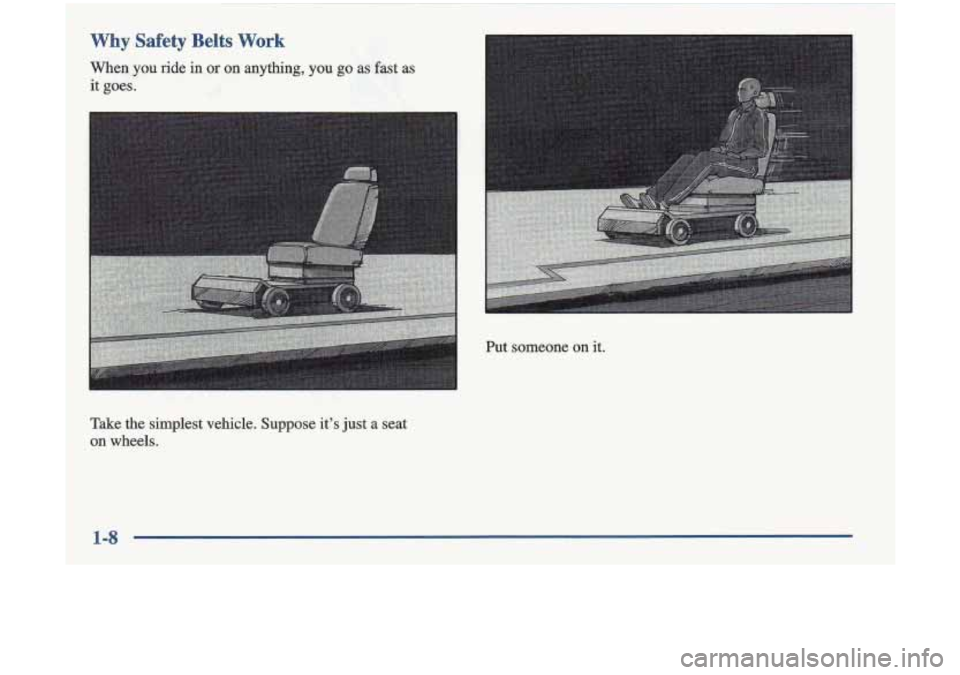
Take the simplest vehicle. Suppose it’s just a seat
on wheels.
Put someone on it.
1-s
Page 34 of 348
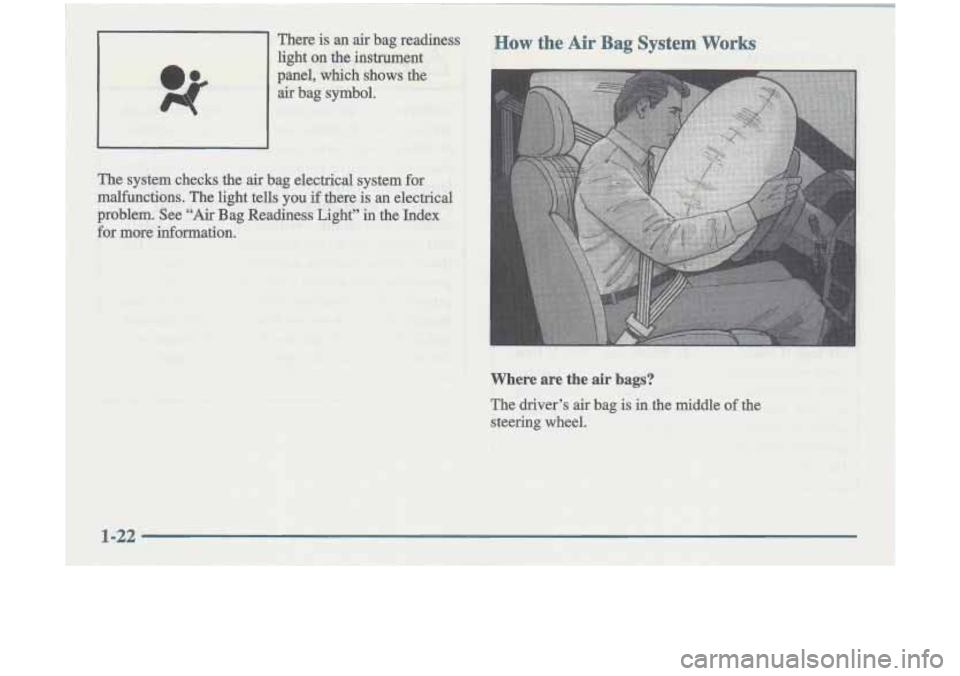
Where are the air bags?
The driver's air bag is in the middle of the
steering wheel.
Page 36 of 348
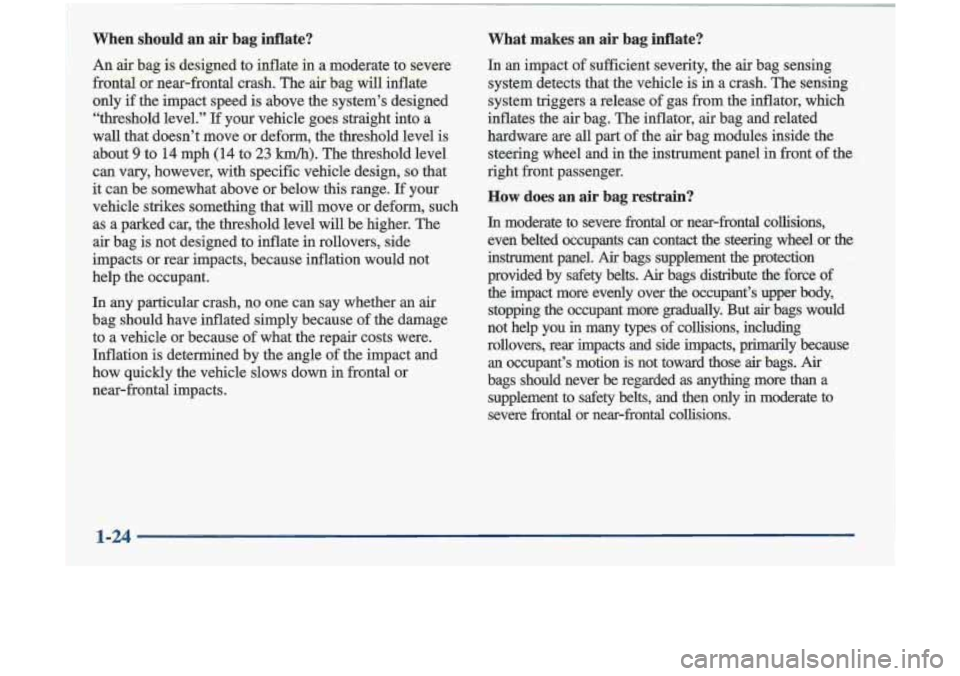
When
An air
should an air bag inflate?
bag is designed to inflate in a moderate to severe
frontal or near-frontal crash. The air bag will inflate only if the impact speed is above the system’s designed
“threshold level.”
If your vehicle goes straight into a
wall that doesn’t move or deform, the threshold level is
about
9 to 14 mph (14 to 23 km/h). The threshold level
can vary, however, with specific vehicle design,
so that
it can be somewhat above or below this range. If your
vehicle strikes something that will move or deform, such as a parked car, the threshold level will be higher. The
air bag is not designed to inflate in rollovers, side
impacts or rear impacts, because inflation would not
help the occupant.
In any particular crash, no one can say whether an air
bag should have inflated simply because of the damage
to a vehicle or because of what the repair costs were.
Inflation is determined by the angle of the impact and
how quickly the vehicle slows down in frontal or
near-frontal impacts.
~~ , ~ ~~ . ~~~ . ~~
What makes an air bag inflate?
In an impact of sufficient severity, the air bag sensing
system detects that the vehicle is in a crash. The sensing
system triggers a release of gas from the inflator, which
inflates the air bag. The inflator, air bag and related
hardware are all part of the air bag modules inside the
steering wheel and in the instrument panel in front
of the
right front passenger.
How does an air bag restrain?
In moderate to severe frontal or near-frontal collisions,
even belted occupants can contact the steering wheel or the
instrument panel.
Air bags supplement the protection
provided by safety belts.
Air bags distribute the force of
the impact more evenly over the occupant’s upper body, stopping the occupant more gradually. But
air bags would
not help you
in many types of collisions, including
rollovers, rear impacts and side impacts, primarily because
an occupant’s motion is not toward those
air bags. Air
bags should never be regarded as anythng more than a
supplement to safety belts, and then only
in moderate to
severe frontal or near-frontal collisions.
1-24
Page 37 of 348
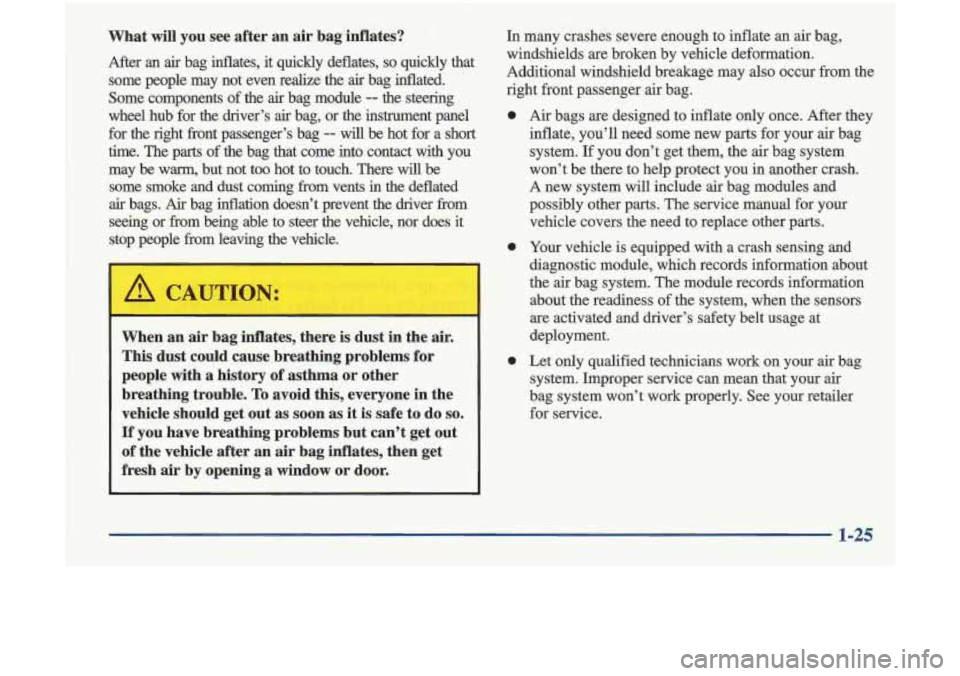
What will you see after an air bag inflates?
After an air bag inflates, it quickly deflates, so quickly that
some people may not even realize the
air bag inflated.
Some components of the
air bag module -- the steering
wheel hub for the driver’s
air bag, or the instrument panel
for the right front passenger’s bag
-- will be hot for a short
time. The parts of the bag that come into contact with you
may be wm, but not too hot to touch. There
will be
some smoke and dust coming from vents in the deflated
air bags. Air bag inflation doesn’t prevent the driver kom
seeing or from being able to steer the vehicle, nor does
it
stop people kom leaving the vehicle.
I
L
~ ~~ ~~
When an air bag inflates, there is dust in the air.
This dust could cause breathing problems for
people with a history of asthma
or other
breathing trouble.
To avoid this, everyone m the
vehicle should get out as
soon as it is safe to do so.
If you have breathing problems but can’t get out
of the vehicle after an air bag inflates, then get
fresh air by opening a window or door.
I
In many crashes severe enough to inflate an air bag,
windshields are broken by vehicle deformation.
Additional windshield breakage may also occur from the
right front passenger air bag.
0
0
0
Air bags are designed to inflate only once. After they
inflate, you’ll need some new parts for your air bag
system. If you don’t get them, the
air bag system
won’t be there to help protect you in another crash.
A new system will include air bag modules and
possibly other parts. The service manual for your
vehicle covers the need to replace other parts.
Your vehicle is equipped with a crash sensing and
diagnostic module, which records information about
the
air bag system. The module records information
about the readiness of the system, when the sensors
are activated and driver’s
safety belt usage at
deployment.
Let only qualified technicians work
on your air bag
system. Improper service can mean that your air
bag system won’t work properly. See your retailer
for service.
1-25
Page 38 of 348
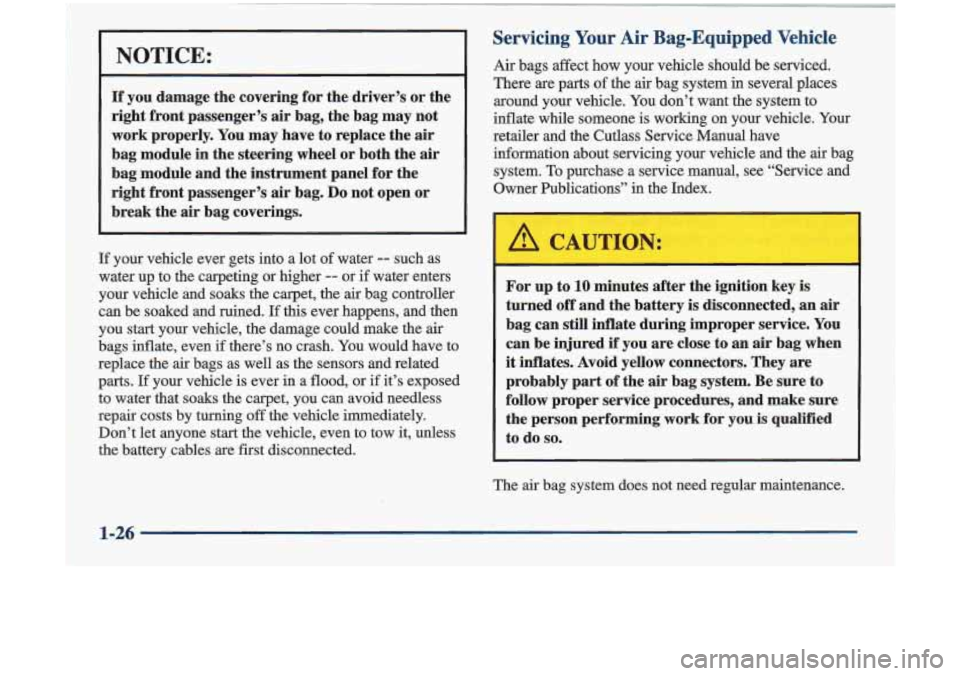
NOTICE:
If you damage the covering for the driver’s or the
right front passenger’s air bag, the bag may not
work properly. You may have to replace the
air
bag module in the steering wheel or both the air
bag module and the instrument panel for the
right front passenger’s
air bag. Do not open or
break the
air bag coverings.
If your vehicle ever gets into a lot of water -- such as
water up to the carpeting or higher
-- or if water enters
your vehicle and soaks the carpet, the air bag controller
can be soaked and ruined. If this ever happens, and then
you start your vehicle, the damage could make the air
bags inflate, even
if there’s no crash. You would have to
replace the air bags as well as the sensors and related
parts. If your vehicle is ever in a flood, or if it’s exposed
to water that soaks the carpet, you can avoid needless
repair costs by turning off the vehicle immediately.
Don’t let anyone start the vehicle, even to tow it, unless \
the battery cables are first disconnected.
~~ ~~~
~~
Servicing Your Air Bag-Equipped Vehicle
Air bags affect how your vehicle should be serviced.
There are parts
of the air bag system in several places
around your vehicle. You don’t want the system to
inflate while someone is working on your vehicle. Your
retailer and the Cutlass Service Manual have
information about servicing your vehicle and the air bag
system. To purchase a service manual, see “Service and
Owner Publications” in the Index.
For up to 10 minutes after the ignition key is
turned off and the battery is disconnected, an air
bag can still inflate during improper service. You
can be injured
if you are close to an air bag when
it inflates. Avoid yellow connectors. They are
probably part of the air bag system. Be sure to
follow proper service procedures, and make sure
the person performing work for you
is qualified
to do
so.
The air bag system does not need regular maintenance.
1-26
Page 65 of 348
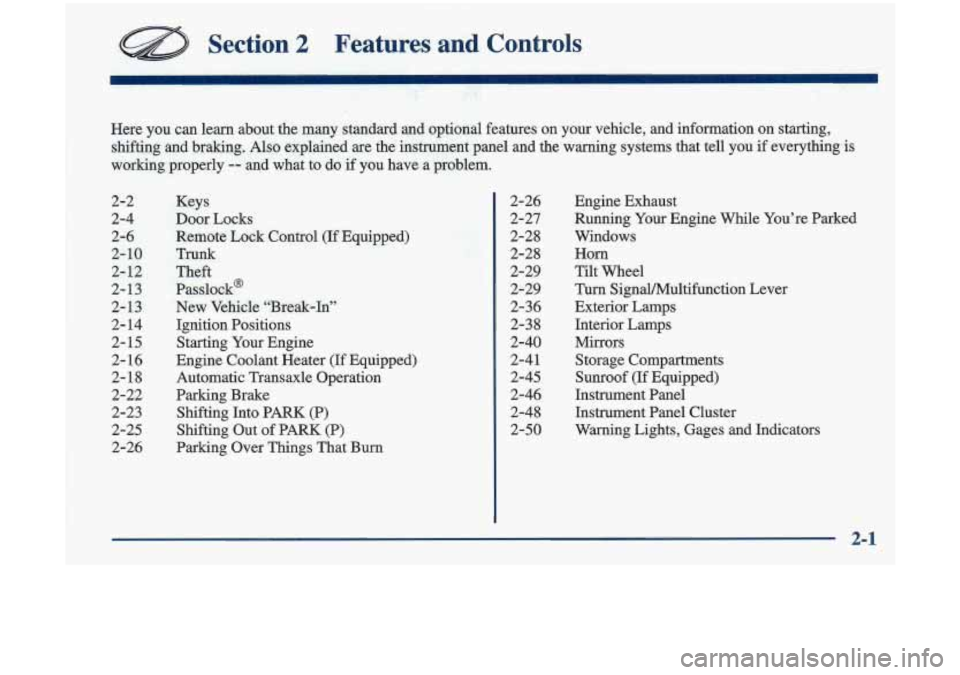
Section 2 Features and Controls
Here you can learn about the many standard and optional features on your vehicle, and inform\
ation on starting,
shifting and braking. Also explained are the instrument panel and the warning systems that tell you
if evewng is
working properly
-- and what to do if you have a problem.
2-2 2-4
2-6
2- 10
2- 12
2- 13
2-13
2- 14
2- 15
2- 16
2-18
2-22
2-23 2-25
2-26
Keys
Door Locks
Remote Lock Control
(If Equipped)
TrWnk
Theft Passlock'
New Vehicle "Break-In" Ignition Positions
Starting Your Engine
Engine Coolant Heater
(If Equipped)
Automatic Transaxle Operation
Parking Brake
Shifting
Into PARK (P)
Shifting Out of PARK (P)
Parking Over Things That Bum 2-26
2-27
2-28 2-28
2-29
2-29
2-36
2-38
2-40
2-4
1
2-45
2-46
2-48
2-50 Engine Exhaust
Running
Your Engine While You're Parked
Windows
Horn
Tilt Wheel
Turn Signal/Multifimction Lever
Exterior Lamps Interior Lamps
Mirrors Storage Compartments
Sunroof (If Equipped)
Instrument Panel Instrument Panel Cluster
Warning Lights, Gages and Indicators
2-1
Page 82 of 348
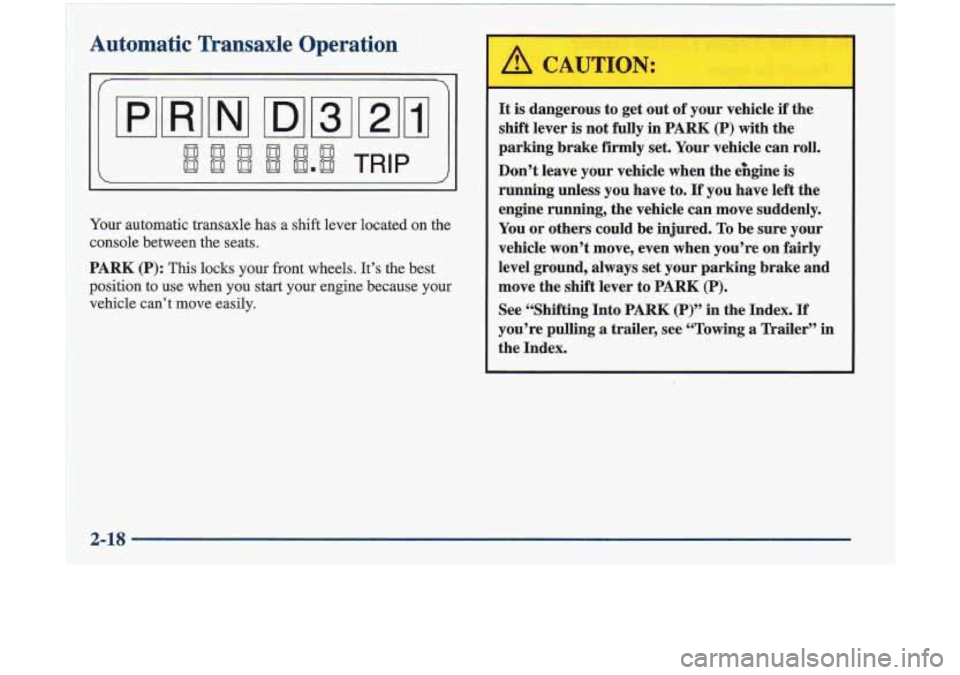
Automatic ’hansaxle Operation
k Tour automatic transaxle has a shift lever located on the
console between the seats.
PARK (P): This locks your front wheels. It’s the best
position to use when you start your engine because your
vehicle can’t move easily.
It is dangerous to get out of your vehicle if the
shift lever is not fully in PARK (P) with the
parking brake firmly set. Your vehicle can roll.
Don’t leave your vehicle when the e&&e
is
running unless you have to. If you have left the
engine running, the vehicle can move suddenly.
You or others could be injured.
To be sure your
vehicle won’t move, even when you’re
on fairly
level ground, always set your parking brake and
move the shift lever to
PARK (P).
See “Shifting Into PARK (P)” in the Index. I€
you’re pulling a trailer, see “Towing a Trailer” in
the Index.
2-18
Page 83 of 348
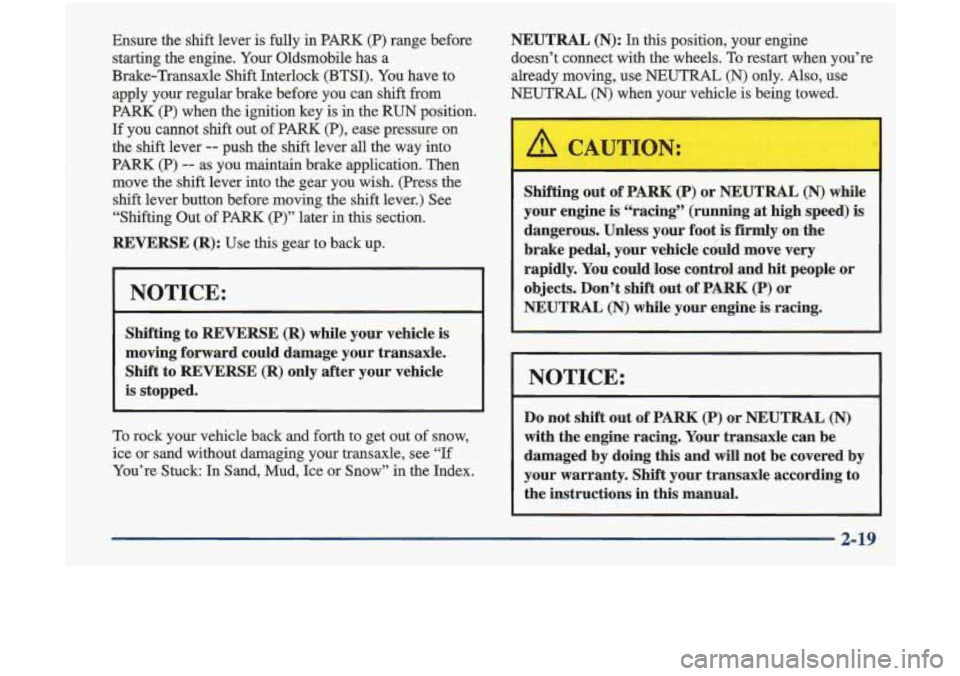
Ensure the shift lever is fully in PARK (P) range before
starting the engine. Your Oldsmobile has a
Brake-Transaxle Shift Interlock (BTSI). You have to
apply your regular brake before you can shift from
PARK
(P) when the ignition key is in the RUN position.
If you cannot shift out of PARK (P), ease pressure on
the
shift lever -- push the shift lever all the way into
PARK (P)
-- as you maintain brake application. Then
move the shift lever into the gear you wish. (Press the
shift lever button before moving the shift lever.) See
“Shifting Out of PARK
(P)” later in this section.
REVERSE (R): Use this gear to back up.
NOTICE:
Shifting to REVERSE (R) while your vehicle is
moving forward could damage your transaxle.
Shift to
REVERSE (R) only after your vehicle
is stopped.
To rock your vehicle back and forth to get out of snow,
ice or sand without damaging your transaxle,
see “If
You’re Stuck: In Sand, Mud, Ice or Snow” in the Index.
NEUTRAL (N): In this position, your engine
doesn’t connect with the wheels.
To restart when you’re
already moving, use
NEUTRAL (N) only. Also, use
NEUTRAL (N) when your vehicle is being towed.
Shifting out of PARK (P) or NEUTRAL (N) while
your engine is “racings’ (running
at high speed) is
dangerous. Unless your foot is firmly on the
brake pedal; your vehicle cdd move very
rapidly. You could lose control and hit people or
objects. Don’t shift out
of PARK (P) or
NEUTRAL
(N) while your engine is racing.
NOTICE: I
Do not shift out of PARK (P) or NEUTRAL (N)
with the engine racing. Your transaxle can be
damaged
by doing this and will not be covered by
your warranty. Shift your transaxle according to
the instructions in this manual.
2-19
Page 85 of 348
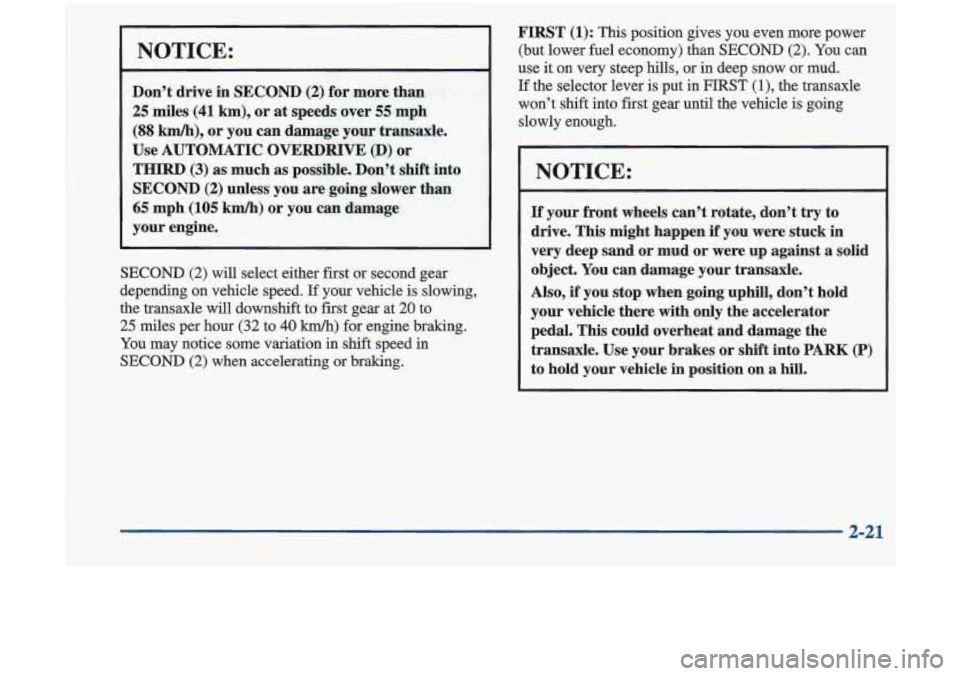
NOTICE:
Don’t drive in SECOND (2) for m,ore than
25 miles (41 km), or at speeds over 55 mph
(88 km/h), or you can damage your transaxle.
Use AUTOMATIC
OVERDRIVE (D) ‘or
THIRD (3) as much as possible. Don’t shift into
SECOND (2) unless you are going slower than
65 mph (105 kmk) or you can damage
your engine.
SECOND (2) will select either first or second gear
depending on vehicle speed. If your vehicle is slowing,
the transaxle will downshift to first gear at
20 to
25 miles per hour (32 to 40 km/h) for engine braking.
You may notice some variation in shift speed in
SECOND
(2) when accelerating or braking.
FIRST (1): This position gives you even more power
(but lower fuel economy)
than SECOND (2). You can
use it on very steep hills, or in deep snow or mud.
If the selector lever is put in FIRST (1)’ the transaxle
won’t
shift into first gear until the vehicle is going
slowly enough.
NOTICE:
If’ your front wheels can’t rotate, don’t try to
drive. This might happen if you were stuck in
very deep sand
or mud or were up against a solid
object. You can damage your transaxle.
Also,
if‘ you stop when going uphill, don’t hold
your vehicle there with only the accelerator
pedal. This could overheat and damage the
transaxle. Use your brakes or shift into PARK
(P)
to hold your vehicle in position on a hill.
Page 92 of 348
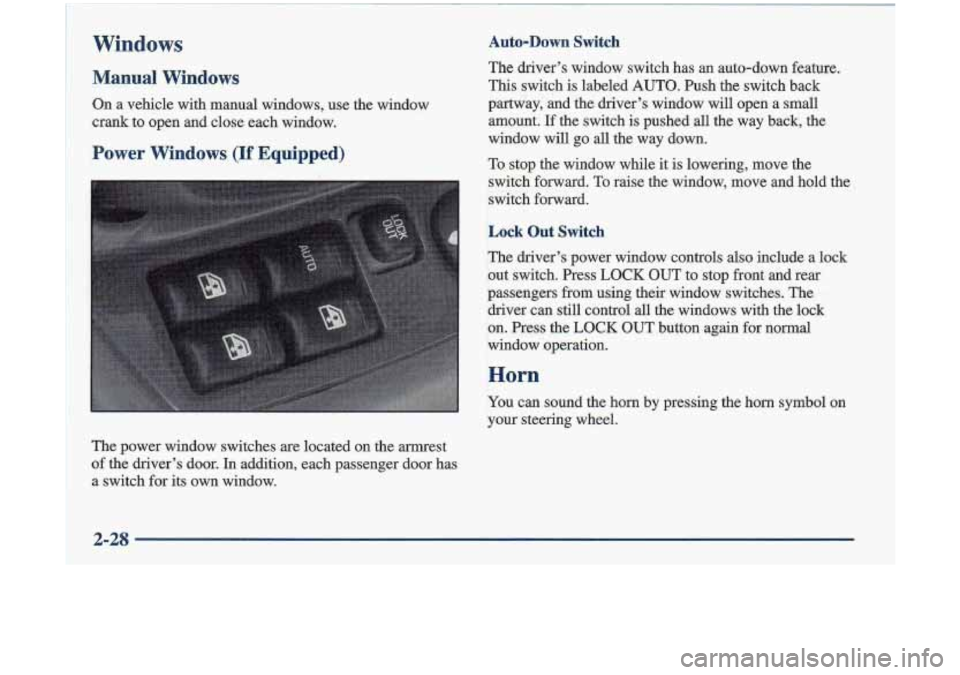
Windows
Manual Windows
On a vehicle with manual windows, use the window
crank to open and close each window.
Power Windows (If Equipped)
The power window switches are located on the armrest
of the driver’s door.
In addition, each passenger door has
a switch for its own window.
Auto-Down switch
The driver’s window switch has an auto-down feature.
This switch is labeled AUTO. Push the switch back
partway, and the driver’s window will open a small
amount.
If the switch is pushed all the way back, the
window will go all the way down.
To stop the window while it
is lowering, move the
switch forward. To raise the window, move and hold the
switch forward.
Lock Out Switch
The driver’s power window controls also include a lock
out switch. Press
LOCK OUT to stop front and reat
passengers from using their window switches. The
driver can still control all the windows with the lock
on. Press the LOCK OUT button again for normal
window operation.
P .. ,.
Horn
You can sound the horn by pressing the horn symbol on
your steering wheel.
2-28